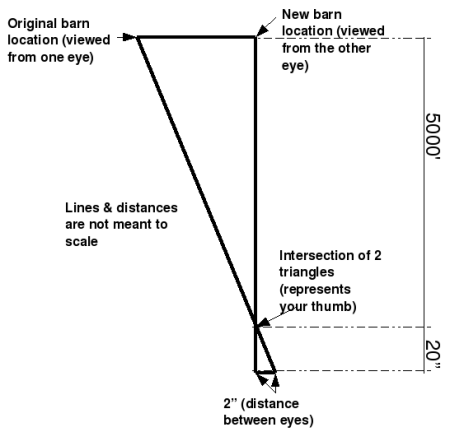This post is about a web article which mentions a technique that allows you to estimate, to a relatively good degree, your distance from another object. I’ll then explain the minor error which the article has, as well as the assumptions of the technique which the web article did not mention.
The Technique
I came across this neat trick from lifehacker.com about estimating distances using your arm and thumb. It is quite useful, but below I will outline a relatively minor error of the article, particularly the diagram used. It was a minor error but it still strikes me as something that should be brought to light, since it’s pretty trivial too. The original article btw was taken from the almanac.com article of the same name. Both articles were quite short so they only took me a small amount of time to read through them and to quickly notice that there was something wrong with the diagram.
The articles emphasize the fact that one’s arm (held straight) is approximately 10 times longer than the distance between your eyes. The articles also mention that with a bit of applied trigonometry, one can estimate distances between you and an object which you have a reliable width knowledge of. Unfortunately the article writer/s might have focused on the trigonometry part too much, overlooking their basic geometry when they created the diagram.
Here is the original almanac.com diagram showing a man estimating his distance from a barn which he originally knows the approximate width.

How The Technique Works
In case you haven’t read the original article yet, it basically says that (again from almanac.com):
Hold one arm straight out in front of you, elbow straight, thumb pointing up.
Close one eye, and align one edge of your thumb with one edge of the barn.
Without moving your head or arm, switch eyes, now sighting with the eye that was closed and closing the other.
- Your thumb will appear to jump sideways as a result of the change in perspective.
How far did it move? (Be sure to sight the same edge of your thumb when you switch eyes.)
Let’s say it jumped about five times the width of the barn, or about 500 feet.
Now multiply that figure by the handy constant 10 (the ratio of the length of your arm to the distance between your eyes).
Now you get the distance between you and the barn—5,000 feet, or about one mile. The accompanying diagram should make the whole process clear (shown above).
The Error In The Original Diagram
The error comes from the fact that the original diagram, whether it be the vertical one from almanac.com or the horizontal, modified version from lifehacker.com, show the distance line not being parallel to one line common to both triangles formed. To see this more clearly, I’ve created a little more technical and descriptive diagram below. The new diagram shows, correctly, that the distance line (containing the 5000′ and 20” distance markings) is parallel to the line connecting the observer’s left eye to the barn’s new location. That’s it. That’s the error 🙂 It may seem trivial, and it actually is, but I couldn’t help noticing it, especially since apparently no one has commented about it, and some people I know who should have noticed it, didn’t. 🙂 The original diagram shows the left-eye-new-barn-location line to be non-parallel to the distance line, which is wrong, and which quickly caught my skeptical eye. Basic geometry will tell you that my new diagram below is the more correct one.

Assumptions Which Were Left Out
The assumptions which the article does not mention include:
- One knows a relatively precise measurement of the object’s width, or that one should know a good deal about the object’s width before attempting to estimate distance with this technique. To see how this can become a problem if not entirely taken into consideration, suppose you estimated or falsely remembered that the barn was 400ft instead of 500ft. That would translate to your estimated distance of 4000ft, which is 1000ft shorter than the correct 5000ft! 🙂 You’d then get a nasty surprise since you left out 1000ft. In other words, since the ratio of the object’s width to the distance between it and you is 10, your width estimation errors (again, could be from wrong estimation or remembrance of the object’s width) get translated to a distance error multiplied by 10.
- The topography of the terrain. This technique assumes or works best in a plain, since if you were say in a hilly or mountainous region, the distance you’ll get from this technique is the straight line distance from you to the object. But it does not take into consideration the slope, nor the crests or troughs of the land. You may get a distance of 1000ft between you and the object, but if there are hills and such between you and the object, you know it will be more than 1000ft. 🙂
Gracias a mis amigos Rudolf y Aaron. Thanks to my friends Rudolf and Aaron for their quick help in confirming this error, since I wanted to be triply sure. 🙂